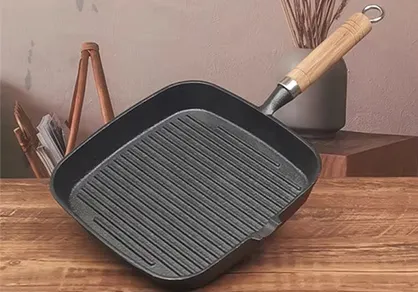
seasoned cast iron skillet
The Marvel of Seasoned Cast Iron Skillets A Timeless Kitchen Essential
When it comes to versatile cooking tools, few can rival the seasoned cast iron skillet. This kitchen workhorse has been a staple in homes for centuries, cherished for its durability, heat retention, and natural non-stick properties. As we delve into the world of cast iron, we’ll explore how to care for it, the reasons behind its enduring popularity, and some delicious recipes that benefit from its unique qualities.
The Benefits of Seasoning
At the heart of every cast iron skillet is the seasoning process, which involves the application of a layer of oil that's baked onto the pan’s surface. This not only creates a natural non-stick coating but also helps to prevent rust. Over time, with proper care, the seasoning improves, developing a rich patina that enhances both the skillet's cooking performance and its appearance.
A well-seasoned cast iron skillet can reach high temperatures and distribute heat evenly, making it perfect for tasks like searing meats, frying vegetables, or baking cornbread. Additionally, cast iron skillets are oven-safe and can easily transition from stovetop to oven, making them ideal for recipes that require multi-step cooking.
Care and Maintenance
Maintaining a cast iron skillet is surprisingly simple and requires more love than effort. After each use, it's best to clean the skillet while it’s still warm. A gentle scrub with hot water and a non-abrasive sponge is usually sufficient; for stubborn food residues, a sprinkle of coarse salt can act as an exfoliant. It's important to avoid soap, as it can strip away the seasoning.
Once cleaned, dry the skillet thoroughly to prevent rust, and apply a light coat of cooking oil to preserve the seasoning. Store it in a dry place and avoid stacking cookware on it to protect your seasoning layer.
seasoned cast iron skillet

The Allure of Cooking with Cast Iron
Cooking with a cast iron skillet brings unique benefits that enhance the flavors of your food. Many home cooks appreciate how well it retains and evenly distributes heat, which can lead to perfectly cooked meals. The ability of cast iron to withstand high temperatures also offers an excellent surface for creating a delicious crust on meats.
Furthermore, there is a nostalgic charm and connection to tradition that comes with using cast iron cookware. Many families pass down their skillets from generation to generation, each carrying with it stories of countless meals and memories.
Recipes to Try
1. Classic Skillet Cornbread Start by preheating your oven and placing your cast iron skillet inside. Mix cornmeal, flour, baking powder, sugar, salt, milk, eggs, and melted butter in a bowl. Once the skillet is hot, pour in the batter and bake until golden brown. The skillet gives the cornbread a wonderful crispy crust.
2. Perfectly Seared Steak Season your steak with salt and pepper, then heat your skillet until it’s nearly smoking. Add a little oil before searing the steak for a few minutes on each side. Finish it in the oven if you prefer a more done center. The skillet creates a beautiful crust and enhances the steak’s flavor.
3. Vegetable Medley Sauté seasonal vegetables like zucchini, bell peppers, and asparagus with olive oil, garlic, and herbs directly in the skillet. The cast iron elevates the flavor through its even heating and adds a slight smokiness.
In conclusion, the seasoned cast iron skillet is more than just a cooking tool; it’s a kitchen companion that brings both nostalgia and practicality to the culinary experience. With proper care, it will last a lifetime and will only improve with age, ultimately becoming a cherished part of your kitchen legacy. Embrace the magic of cast iron cooking and discover the joy it brings to your meals.
-
Season Cast Iron Perfectly with GPT-4 Turbo TipsNewsAug.01,2025
-
High Quality Cast Iron Cookware - Baixiang County Zhongda MachineryNewsAug.01,2025
-
Premium Cast Iron Pan: Durable & Perfect HeatNewsAug.01,2025
-
High Quality Kitchen Durable Black Round Cast Iron Cookware Pancake Crepe Pan-Baixiang County Zhongda Machinery Manufacturing Co., Ltd.NewsAug.01,2025
-
Cast Iron Cookware - Baixiang County Zhongda Machinery | Nonstick, Heat ResistanceNewsAug.01,2025
-
High Quality Kitchen Durable Black Round Cast Iron Cookware - Baixiang County Zhongda Machinery | Non-Stick, Heat Retention, DurableNewsJul.31,2025


